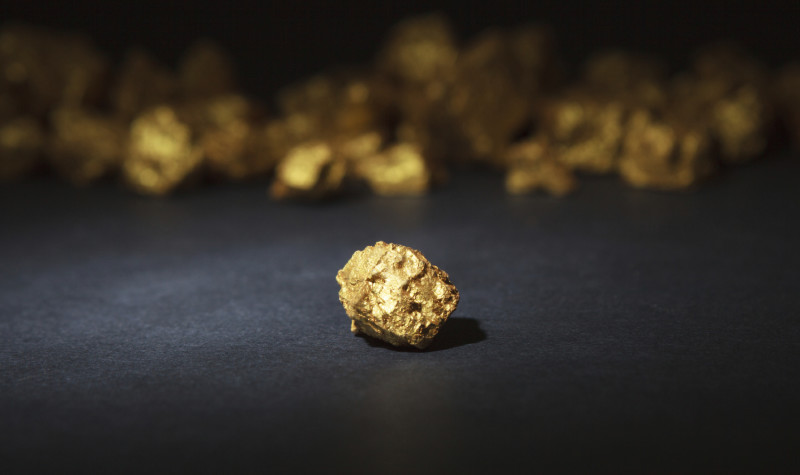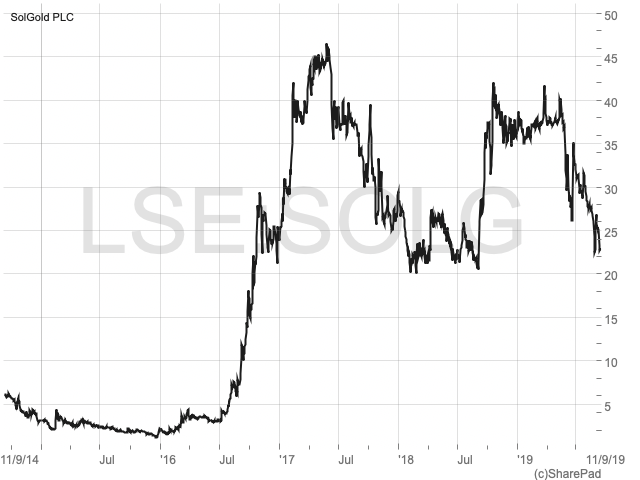Solgold shares have stalled – here’s why…

Solgold, my best tip – up from under 3p in 2015 to a 45p peak in 2017 – has been up and down ever since, like the proverbials in Klondike mining towns.
But what did you expect? Solgold is an exploration company. Such companies are always very long-term endeavours (Solgold particularly so, with many large concessions hardly yet started to drill) and react to news of finds, and to erratic commodity prices. Despite its name, Solgold’s focus now is in copper-rich South America and no longer in gold-rich Australia and the Solomon Islands. Its very preliminary plan to start producing in, hopefully, eight years’ time from Alpala, the first of its finds at Cascabel (a ten-year world best) in Ecuador, shows only 21% by value in gold (at present prices). The rest will be mostly copper, which is down by 18% in six months on fears for China (historically taking nearly 50% of world production) and flagging prospects for electric cars (hoped to take up any Chinese slack).
Last year the shares were buoyed by an 11.1% stake taken by BHP Billiton, added to Newcrest Mining’s 14.8% acquired the year before. This year, apart from a short-lived panic caused by a local attempt to ban mining at Cascabel (now rebuffed), it has been copper’s decline that has been the major influence. The majors have probably got the stakes they want, leaving mostly small investors playing the shares in relatively low volumes, and it is their propensity to lose patience and to react to weak copper prices and, increasing of late, fears of a cash raise, that is all that is needed to explain the weakness.

Followers will know more, including of the awkward stake held by TSX Cornerstone Resources which Solgold says it wants to buy because it is blocking the corporate deals it might otherwise make. However, here I’ll concentrate on what has been little discussed so far – Solgold’s real value, and how the story might play out. What follows is my own speculation.
Some hope BHP or Rio Tinto will bid for the whole of Solgold, but I believe they will bide their time and wait to cherry-pick while Solgold continues to pay for further exploration. Meanwhile, Cascabel will have to be somehow hived off, perhaps separately to Solgold shareholders. Otherwise, the substantial funds needed to drill Solgold’s 12 other promising prospects in Ecuador over the next ten years or so (hardly started as yet, although Solgold might invite others in to share the cost) will dilute Cascabel’s value to the Solgold share price – ie to the share price that Cascabel alone would warrant if not diluted by funding for Solgold’s follow-on prospects.
So this is CEO Nick Mather’s strategic problem (which he will no doubt seek to mitigate with the appropriate spin): to juggle the diluting costs of expansion without inhibiting an otherwise rising share price. Helping him in this task is the Preliminary Economic Analysis for developing Alpala that Solgold has come up with. A PEA is not very accurate and a better Preliminary Feasibility Study (PFS) is being worked on for publication by March next year, but first estimates show $2.8bn (five times Solgold’s market value) to build, and (at a 25% higher copper price than today’s) a $4.5bn Net Present Value (ie a $7.3bn present value to come once construction is paid for and production starts) so we can make a rough stab at shareholder value and where the build cost might come from.
| Master Investor Magazine
Never miss an issue of Master Investor Magazine – sign-up now for free! |
Readers will know that I am scathing about brokers’ ‘target’ share prices based on dividing a project’s NPV by some guess (usually far too optimistic) at shares in issue when up and running. The brokers of course don’t explain. Do they mean the shares will get there eventually? In practice they never even get near, because that logic is flawed, especially for long life projects. (Remember Sirius Minerals? Look how that turned out!) With Alpala, they are touting a 70-110p share price ‘target’ for Solgold.
A key problem is that NPVs don’t show the crucial detail that a bidding miner or banker will want. Very different cash flow profiles can deliver the same NPV, making analysts’ ‘targets’ even more inaccurate.
That’s why the only reliable method to arrive at a deserved share price is to more accurately forecast numbers in issue after all the necessary funding and its cost. In this case it has to be on the assumption that Solgold will ‘ring fence’ Cascabel from the dilution resulting from funding its other projects (rather than – as some suggest – selling down Cascabel in stages). Otherwise, any share price forecast will be even more meaningless.
For Alpala, Solgold says it is discussing a ‘conditional funding package’ (aka project finance) which it hopes will be concluded along with the PFS by Q1 next year.
This can be a complex tier of different risk/return loans and equity, but with Alpala’s reasonable (but not outstanding) 20-25% rate of return (provided copper recovers), the banks might lend 50% or more, and maybe BHP and Newcrest will ‘earn in’ at the project level with some equity. All those will detract from Solgold’s interest, although its spending to prove up Alpala will likely have totalled at least $300-$400m ($143m spent up to last June, $60m in the last year) by financial close, which will earn it a 10-15% share of the post-construction present value without contributing any more. That would be worth a $650m to $750m PV – or 35p – to Solgold on present shares in issue – but only when production starts.
That, I believe, is the real ‘floor’ to Solgold’s share price that major miners, professionals, and institutions will be going by at present (although that will rise with any drill results that expand the value of the present, known, Alpala resource, as seems on the cards) and taking no notice of brokers’ ‘targets’.
The PEA for Alpala shows most of its return in the first ten years of production, with the rest of its 56-year life not nearly as profitable (unless copper rises). But its outlay of $2.4bn in the first five years from construction start will have been fully recouped after year eight, and by year 15 will have clocked up a net cash profit (after taxes and royalties) totalling about $8bn. The rich rock core as presently known will be depleted after that, so profits will decline, but will still clock up a $16bn total by year 37. That’s half a lifetime, so much will have changed in the meantime. In fact, we’re probably looking at much higher copper prices and therefore much higher profits. It is that long life and scope to grow the resource and its value that ought to attract someone to help Solgold develop it.
But what about the rest of Solgold?
Solgold’s Nick Mather has made much of the first mover foothold it has built up in the hitherto little explored part of the Andean copper belts in Ecuador, where Solgold now claims 12 other prospects, identified using the same state-of-the-art airborne magnetic modelling that found Cascabel, and some of which Mather is already enthusing about.
However, confirmation drilling has not yet started, although it is planned to do so in the current financial year. Consequently, along with Cascabel – where drilling is also stepping up to (hopefully) expand the resource and provide the detail for the PFS and DFS now in preparation – Solgold’s spending looks set to increase substantially compared with the $72m spent in the latest year to June on exploration, on top of some $10m other company costs. So, with $38m net cash in the balance sheet at end-June, another large cash call will be coming by the end of the year.
At the present share price, the necessary amount if raised from shareholders might add 10% to shares in issue. Alternatively, it might be raised from others including BHP and Newcrest buying in.
So I can’t see much in the near future that will spur the shares higher – unless copper recovers sharply or the major shareholders subscribe for more (once out of their ‘standstill’ periods), which is unlikely to be at a price higher than the 35-40p levels we’ve seen before. So I expect the shares to stay trading in the 20p-40p range, although they are currently testing the base. (Chart nerds would probably agree.)
In the very long term, it is worth bearing in mind that finding Cascabel, with the big share jump it engendered, is not bad for what was just a gleam in Solgold’s (and the market’s) eye only four years ago when the shares were sub 3p. So, if just one of the 12 other prospects start to show a possible second Cascabel, they could see another surge.
And for reasons I’ve already mentioned, any more such Cascabels will probably have to be hived off separately, probably to existing shareholders. So who knows? In ten years’ time (as long as it took Ivanhoe Mines to prove up the giant Oyu Tolgoi copper mine in Mongolia, now controlled by Rio Tinto) today’s Solgold shareholders might have a portfolio of five or six ‘Cascabels’ – each as large as Solgold today!

Comments (0)